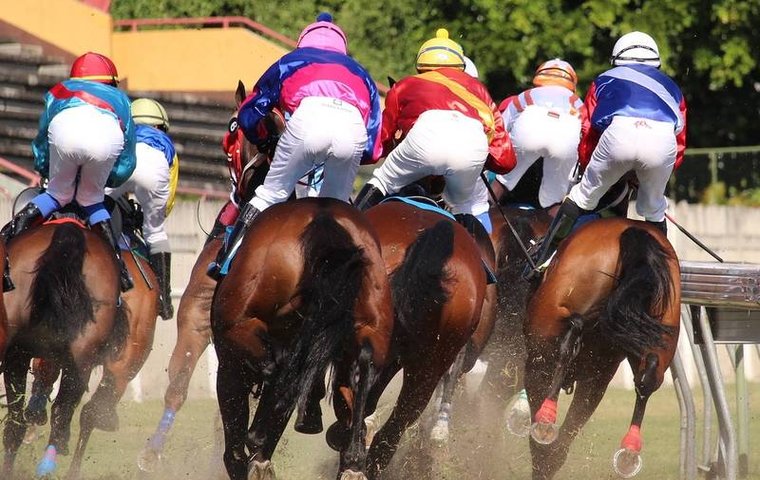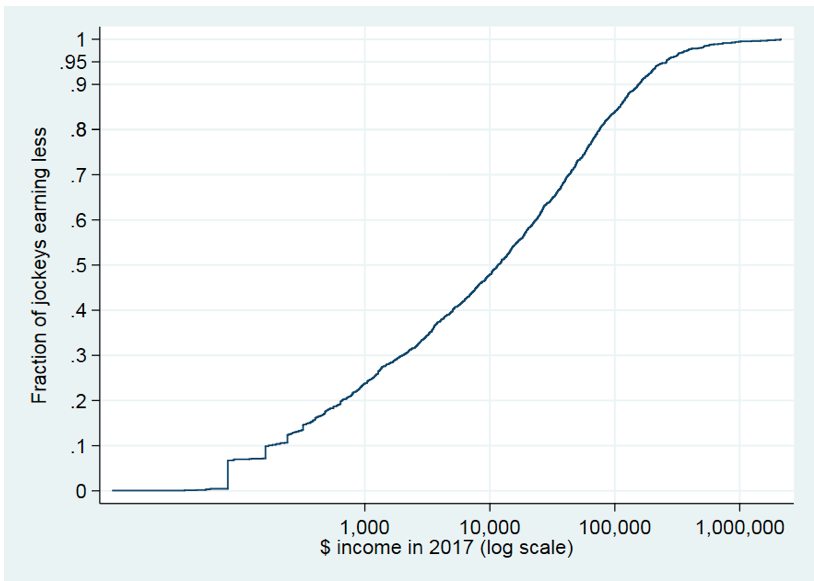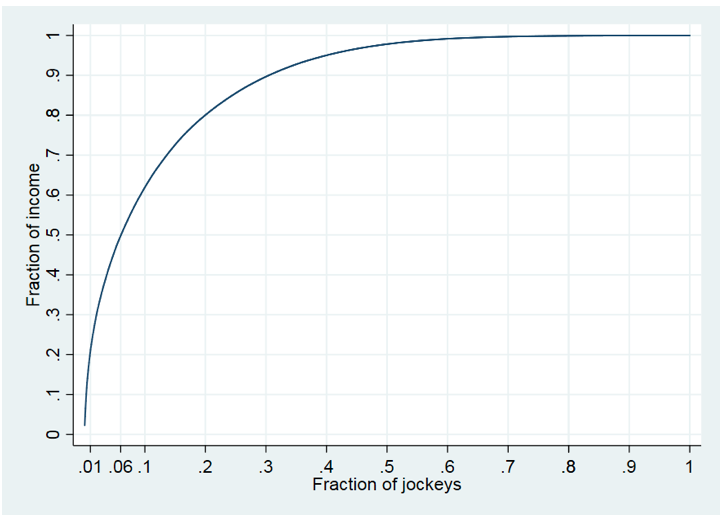
Life is good if you’re an elite jockey. You ride the best horses in the best races, and you can earn a not-so-small fortune. But what of those at the other end of the scale? How do they fare? Here, in the first of two articles looking at the inequality issue among jockeys based in the U.S., Paul von Hippel, associate professor at the University of Texas, examines some key data. The second article is on Tuesday.
In a 1957 interview with Mike Wallace, Hall of Fame jockey Eddie Arcaro acknowledged he’d made about $2.2 million in his 25-year career — equivalent to about $30 million today.[1]
However, Arcaro said, “There are 950 active riders in the United States, and I think the average rider doesn't make a living … The average rider probably makes about $7,500 a year and, traveling with the family and everything, I actually don’t believe he makes a living.”
Incomes are at least as unequal today. The top few riders make up to $2 million per year, but half North America’s 1,559 Thoroughbred jockeys earn less than $12,000 per year — equivalent to $1,356 in 1957 dollars.
This isn’t exactly a secret, but it’s not something the racing business brags about, and it’s a little hard to figure out from published data. Unlike other sports — football, baseball, tennis, basketball — racing doesn’t disclose what its athletes earn. Instead of reporting what a jockey earns, racing reports how much prize money has been won by the horses under the jockey’s saddle.
Jockeys get just a small fraction of that prize money. A simple rule of thumb is that jockeys get eight percent[2], but that’s only true on average. According to the Jockeys’ Guild, the winning jockey gets ten percent of the first place prize money, and the second and third place jockeys get five percent of the second and third place prize money.
To put that in perspective, the average purse in a 2017 race was $27,000 — with 49 percent for the winning horse, 24 percent for second, and 12 percent for third. So the winning jockey earned, on average, $1,300 (ten percent of 49 percent of $27,000). The average second place jockey got $324, and the average third place jockey got $162.
After third place, jockeys’ pay depends on the state and purse. In Kentucky, races with purses of at least $100,000 pay the fourth place jockey five percent of the fourth place prize money. (Fourth place horses win, on average, nine percent of the purse, though gamblers who bet on them are out of the money.)
The elite fifteen
In poorer races, or for finishing worse than fourth, the jockey gets a mount fee of $50 to $110. The amounts vary across states, depending on what the Jockeys’ Guild has agreed with each state racing association. But it wouldn’t be a great distortion to act as though the Kentucky agreement applies nationwide.
Under that assumption, we can approximate the cumulative distribution of jockeys’ income. It’s strikingly unequal.
In 2017, the bottom quarter of jockeys made less than $1,200, the bottom half made less than $12,000, and the bottom three-quarters earned less than $59,000. On the other hand, the top ten percent earned more than $155,000, the top five percent more than $258,000, and the top one percent — just 15 jockeys — earned between $729,000 and $2.1 million.

The figures in the vertical axis show the lowest-paid jockeys at the bottom (0 to .1 being the lowest-paid ten percent) and the highest at the top (.9 to 1 being the highest-paid ten percent). The horizontal axis is the amount earned, showing the highest-paid riders earning $1 million or more
Another way to see inequality is to look at the share of income earned by different fractions of jockeys. Jockeys’ incomes follow the 80/20 rule, with 20 percent of jockeys earning 80 percent of income. But incomes are even more concentrated at the high end. The top 6 percent of jockeys earn half the income. The top 1 percent of jockeys earn over 20 percent of income.
 The vertical axis indicates the percentage of income earned, and the horizontal axis the percentage of jockeys earning it. So, the point on the horizontal axis showing .06 (six percent of jockeys) meets the vertical point of .5 (50 percent of income)
The vertical axis indicates the percentage of income earned, and the horizontal axis the percentage of jockeys earning it. So, the point on the horizontal axis showing .06 (six percent of jockeys) meets the vertical point of .5 (50 percent of income)
The most common index of inequality is the Gini coefficient, which for jockeys was .77 in 2017. That’s considerably higher than the income inequality among major league baseball players, who had a Gini coefficient of .62 (and a minimum wage of $535,000) in 2017. But perhaps it’s not fair to compare the incomes of all jockeys to the incomes of major leaguers. A lot of jockeys are effectively minor leaguers, who race infrequently on small tracks.
If baseball data included minor leaguers, its pay would be more unequal (and lower). Still, it may be inevitable for income to be more unequal in a sport that depends on prize money — like horse racing, tennis, or boxing — than in a sport like baseball, where athletes collect a salary.
The distribution of jockeys’ incomes has changed very little in this century; the only increase has come at the very high end, and that hasn’t even kept up with inflation. In 2000, the Gini coefficient was .75; the median income was $11,901 and the 95th percentile was $216,000 ($312,000 in today’s dollars). In 2017 the median income was $11,629 and the 95th percentile was $258,307; the Gini coefficient was .77.
Not much about jockeys’ incomes has changed since 2000. And perhaps not much has changed, except for inflation, since Mike Wallace interviewed Eddie Arcaro in 1957.
[1] $2.2 million in 1957 is equivalent to almost $20 million today, but Arcaro made most of his money before 1957. Before adjusting for inflation, I assigned his $2.2 million in winnings to 1944, which was near the peak of his career, between his two Triple Crowns.
[2] In Arcaro’s interview with Wallace, Wallace assumed that Arcaro got ten percent of his horses’ prize money, and Arcaro didn’t correct him. I don’t know if ten percent was an accurate figure in 1957, but it would be an overestimate today.
Who are the highest-paid one percent, and how do they do it? Read part two here


